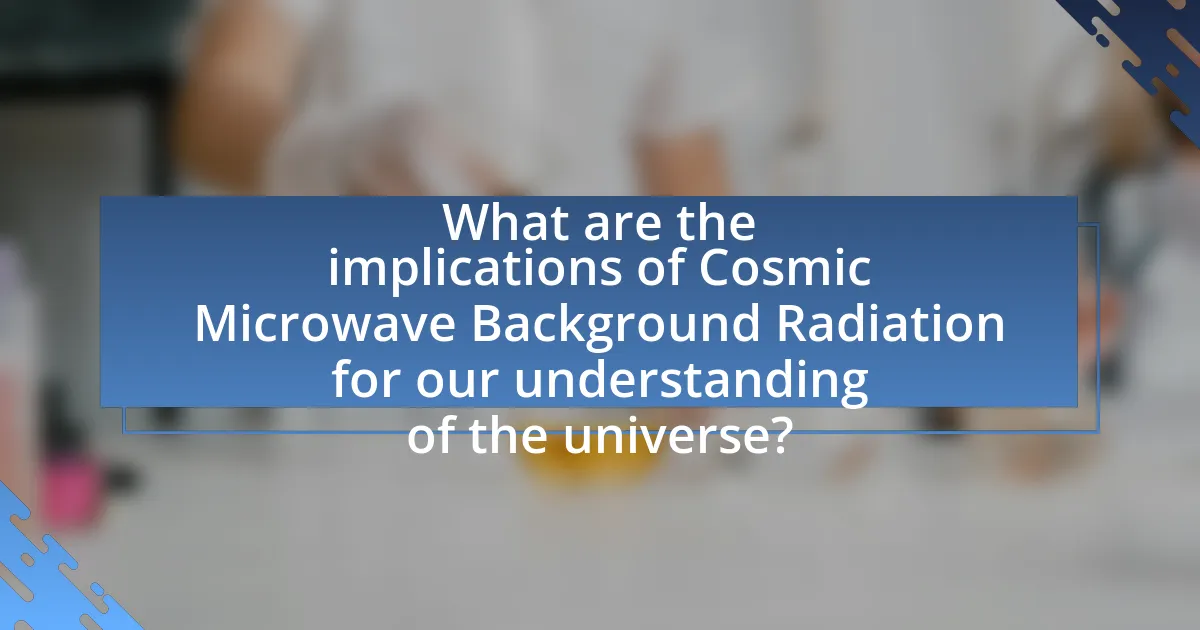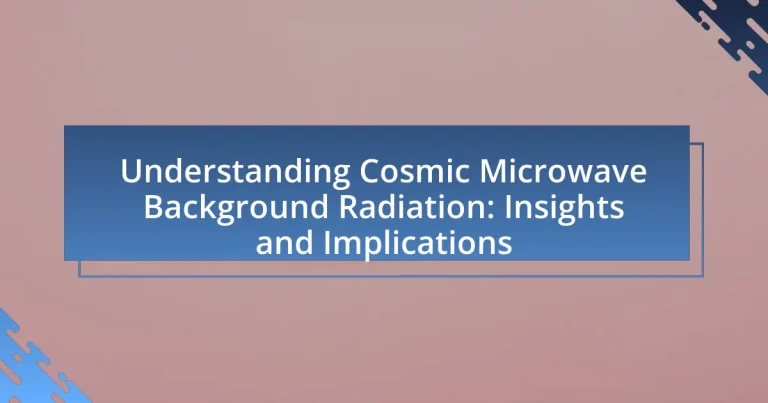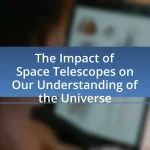Cosmic Microwave Background Radiation (CMBR) is the remnant radiation from the Big Bang, providing crucial evidence for the universe’s early conditions and supporting the Big Bang theory. Discovered in 1965 by Arno Penzias and Robert Wilson, CMBR has a uniform temperature of approximately 2.7 Kelvin and exhibits slight fluctuations that reveal information about the density variations in the early universe. Key experiments, including those conducted by the Wilkinson Microwave Anisotropy Probe (WMAP) and the Planck satellite, have refined our understanding of cosmological parameters such as the universe’s age, composition, and the role of dark energy. This article explores the significance of CMBR in cosmology, its implications for theories of cosmic inflation, and the ongoing research aimed at further understanding the universe’s evolution.

What is Cosmic Microwave Background Radiation?
Cosmic Microwave Background Radiation (CMBR) is the afterglow radiation from the Big Bang, filling the universe and providing a snapshot of its early state. Detected uniformly across the sky, CMBR has a temperature of approximately 2.7 Kelvin and is a critical piece of evidence supporting the Big Bang theory. Its existence was first predicted by George Gamow in the 1940s and later confirmed by Arno Penzias and Robert Wilson in 1965, who received the Nobel Prize for their discovery. This radiation carries information about the universe’s formation, structure, and evolution, making it essential for cosmology and our understanding of the universe.
How was Cosmic Microwave Background Radiation discovered?
Cosmic Microwave Background Radiation (CMB) was discovered in 1965 by Arno Penzias and Robert Wilson, who detected a persistent noise in their radio antenna that could not be attributed to any known source. This discovery was significant because it provided evidence for the Big Bang theory, as the CMB is considered the afterglow of the hot, dense state of the early universe. Penzias and Wilson’s findings were later confirmed by the theoretical predictions made by George Gamow and others regarding the existence of this radiation, which is uniform across the sky and has a temperature of approximately 2.7 Kelvin. Their work earned them the Nobel Prize in Physics in 1978, solidifying the CMB’s role as a cornerstone in cosmology.
What key experiments contributed to the discovery of Cosmic Microwave Background Radiation?
The key experiments that contributed to the discovery of Cosmic Microwave Background Radiation (CMBR) include the work of Arno Penzias and Robert Wilson in 1965, who detected a persistent noise in their radio antenna that was isotropic and uniform across the sky. This finding was crucial as it matched the predictions of the Big Bang theory, which posited that the universe should be filled with residual radiation from its hot, dense early state. Their measurements indicated a temperature of approximately 3.5 Kelvin, later refined to about 2.7 Kelvin, confirming the existence of CMBR. Additionally, the COBE (Cosmic Background Explorer) satellite launched in 1989 provided further evidence by mapping the CMBR with high precision, revealing fluctuations that corresponded to the density variations in the early universe. These experiments collectively validated the Big Bang model and established CMBR as a cornerstone of cosmology.
Who were the major scientists involved in this discovery?
The major scientists involved in the discovery of Cosmic Microwave Background Radiation (CMB) are Arno Penzias and Robert Wilson. They conducted experiments in 1965 that led to the accidental discovery of the CMB while working at Bell Labs. Their findings provided strong evidence for the Big Bang theory, as the CMB is considered a remnant radiation from the early universe. Penzias and Wilson were awarded the Nobel Prize in Physics in 1978 for their work, which fundamentally changed our understanding of cosmology.
Why is Cosmic Microwave Background Radiation significant in cosmology?
Cosmic Microwave Background Radiation (CMBR) is significant in cosmology because it provides critical evidence for the Big Bang theory and the early universe’s conditions. CMBR is the remnant radiation from the hot, dense state of the universe approximately 380,000 years after the Big Bang, when protons and electrons combined to form neutral hydrogen, allowing photons to travel freely. This radiation is uniform and isotropic, with a temperature of about 2.7 Kelvin, which supports the predictions of cosmic inflation and the expansion of the universe. The detailed measurements of CMBR, particularly from missions like the Wilkinson Microwave Anisotropy Probe (WMAP) and the Planck satellite, have allowed cosmologists to determine key parameters such as the universe’s age, composition, and rate of expansion, thus solidifying its foundational role in modern cosmology.
What information does Cosmic Microwave Background Radiation provide about the early universe?
Cosmic Microwave Background Radiation (CMBR) provides critical information about the early universe, specifically its temperature, density fluctuations, and the conditions present shortly after the Big Bang. The CMBR is a remnant radiation from the hot, dense state of the universe approximately 380,000 years after the Big Bang, revealing a nearly uniform temperature of about 2.7 Kelvin across the sky.
Additionally, the slight anisotropies in the CMBR, measured by missions such as the Wilkinson Microwave Anisotropy Probe (WMAP) and the Planck satellite, indicate the density variations that led to the formation of large-scale structures like galaxies. These fluctuations correspond to the initial conditions of the universe, supporting the inflationary model of cosmology, which posits a rapid expansion of space in the early moments of the universe. Thus, CMBR serves as a crucial observational tool for understanding the universe’s origins and evolution.
How does Cosmic Microwave Background Radiation support the Big Bang theory?
Cosmic Microwave Background Radiation (CMBR) supports the Big Bang theory by providing evidence of the universe’s hot, dense state shortly after its inception. Discovered in 1965 by Arno Penzias and Robert Wilson, CMBR is the remnant radiation from the early universe, uniformly filling space and exhibiting a temperature of approximately 2.7 Kelvin. This uniformity and the specific blackbody spectrum of the CMBR align with predictions made by the Big Bang model, indicating that the universe expanded and cooled over time. Additionally, fluctuations in the CMBR, mapped by missions like the Wilkinson Microwave Anisotropy Probe (WMAP) and the Planck satellite, reveal the density variations that led to the formation of galaxies, further corroborating the Big Bang theory.

What are the properties of Cosmic Microwave Background Radiation?
Cosmic Microwave Background Radiation (CMB) is characterized by its uniformity, isotropy, and blackbody spectrum. The CMB has a temperature of approximately 2.7 Kelvin, indicating it is a remnant from the early universe, specifically from the time of recombination about 380,000 years after the Big Bang. Its isotropic nature means it appears nearly the same in all directions, with slight fluctuations that provide insights into the density variations in the early universe. The blackbody spectrum of the CMB, with a peak wavelength corresponding to microwave frequencies, confirms its thermal origin and supports the Big Bang theory. These properties have been measured with high precision by missions such as the Wilkinson Microwave Anisotropy Probe (WMAP) and the Planck satellite, which have provided detailed maps of the CMB and its anisotropies.
What is the temperature of Cosmic Microwave Background Radiation?
The temperature of Cosmic Microwave Background Radiation is approximately 2.7 Kelvin. This temperature represents the residual thermal radiation from the Big Bang, uniformly filling the universe. Measurements from the COBE (Cosmic Background Explorer) satellite in 1992 confirmed this value, providing strong evidence for the Big Bang theory and the evolution of the universe.
How does the temperature of Cosmic Microwave Background Radiation compare to other cosmic phenomena?
The temperature of Cosmic Microwave Background Radiation (CMBR) is approximately 2.7 Kelvin, which is significantly colder than many other cosmic phenomena. For instance, the surface temperature of stars like the Sun is about 5,500 Kelvin, while the core of stars can reach millions of Kelvin. Additionally, the temperature of supernova remnants can exceed 10 million Kelvin. This stark contrast highlights that CMBR represents the residual thermal energy from the Big Bang, making it one of the coldest known phenomena in the universe.
What does the uniformity of Cosmic Microwave Background Radiation indicate?
The uniformity of Cosmic Microwave Background Radiation indicates that the universe was once in a hot, dense state and has since expanded uniformly. This uniformity supports the Big Bang theory, as it suggests that the early universe was isotropic and homogeneous, meaning it had a consistent temperature and density across vast distances. Measurements from the Wilkinson Microwave Anisotropy Probe (WMAP) and the Planck satellite have shown that the temperature fluctuations in the Cosmic Microwave Background are minimal, reinforcing the idea of a uniform early universe.
What are the fluctuations in Cosmic Microwave Background Radiation?
Fluctuations in Cosmic Microwave Background Radiation (CMBR) refer to the tiny variations in temperature and density observed in the CMBR, which is the afterglow of the Big Bang. These fluctuations are crucial for understanding the early universe’s structure and evolution, as they represent the seeds of all current cosmic structures, such as galaxies and clusters. The measurements of these fluctuations, particularly from missions like the Wilkinson Microwave Anisotropy Probe (WMAP) and the Planck satellite, have shown that the CMBR fluctuations are typically on the order of one part in 100,000, indicating a highly uniform universe with slight deviations that led to the formation of large-scale structures.
How do these fluctuations relate to the formation of large-scale structures in the universe?
Fluctuations in the Cosmic Microwave Background (CMB) radiation are directly related to the formation of large-scale structures in the universe. These fluctuations represent tiny variations in temperature and density in the early universe, which acted as the seeds for gravitational attraction. As matter began to clump together under gravity, these initial density variations led to the formation of galaxies, clusters, and larger cosmic structures. The CMB fluctuations have been measured with high precision by missions such as the Wilkinson Microwave Anisotropy Probe (WMAP) and the Planck satellite, which confirmed that the observed large-scale structures align with the predictions made by the inflationary model of the universe.
What tools are used to measure these fluctuations?
The tools used to measure fluctuations in Cosmic Microwave Background (CMB) radiation include satellite-based observatories such as the Wilkinson Microwave Anisotropy Probe (WMAP) and the Planck satellite. WMAP provided detailed maps of the CMB, revealing temperature fluctuations across the sky, while Planck improved upon these measurements with higher resolution and sensitivity, allowing for more precise analysis of the CMB’s anisotropies. These instruments utilize microwave detectors and advanced data processing techniques to capture and analyze the faint signals of CMB radiation, contributing significantly to our understanding of the universe’s early conditions and structure.

What are the implications of Cosmic Microwave Background Radiation for our understanding of the universe?
Cosmic Microwave Background Radiation (CMBR) provides critical evidence for the Big Bang theory, indicating that the universe began as a hot, dense state and has since expanded. The uniformity and slight fluctuations in CMBR temperature across the sky reveal the early conditions of the universe, supporting the notion of cosmic inflation and the formation of large-scale structures. Measurements of CMBR, particularly from missions like the Wilkinson Microwave Anisotropy Probe (WMAP) and the Planck satellite, have allowed scientists to determine key cosmological parameters, such as the age of the universe, its composition, and the rate of expansion, reinforcing our understanding of cosmic evolution.
How does Cosmic Microwave Background Radiation influence theories of cosmic inflation?
Cosmic Microwave Background Radiation (CMBR) provides critical evidence supporting theories of cosmic inflation by revealing the uniformity and slight anisotropies in the early universe. The CMBR, a remnant from the hot, dense state of the universe shortly after the Big Bang, shows a nearly uniform temperature with tiny fluctuations that correspond to density variations. These fluctuations align with predictions made by inflationary models, which propose that rapid expansion smoothed out the universe while also creating quantum fluctuations that seeded the large-scale structure we observe today. The measurements from the Wilkinson Microwave Anisotropy Probe (WMAP) and the Planck satellite have confirmed these predictions, showing that the observed anisotropies match the theoretical framework of inflation, thus reinforcing the validity of inflationary theories in explaining the early universe’s evolution.
What evidence supports the inflationary model based on Cosmic Microwave Background Radiation?
The evidence supporting the inflationary model based on Cosmic Microwave Background Radiation (CMBR) includes the uniformity and isotropy of the CMBR, which indicates that the universe underwent rapid expansion. This rapid expansion would have smoothed out any initial irregularities, leading to the observed uniform temperature of approximately 2.7 Kelvin across the sky. Additionally, the presence of tiny fluctuations in temperature, known as anisotropies, corresponds to quantum fluctuations that occurred during inflation, as predicted by the model. These fluctuations have been precisely measured by missions such as the Wilkinson Microwave Anisotropy Probe (WMAP) and the Planck satellite, which confirmed the inflationary model by showing a specific pattern of anisotropies consistent with theoretical predictions.
How does Cosmic Microwave Background Radiation challenge existing cosmological models?
Cosmic Microwave Background Radiation (CMBR) challenges existing cosmological models by providing evidence that contradicts the predictions of certain theories, particularly those related to the uniformity and isotropy of the universe. The CMBR, discovered in 1965, is a relic radiation from the Big Bang, and its uniformity across the sky suggests a very early, hot, and dense state of the universe. However, the observed anisotropies in the CMBR, as measured by missions like the Wilkinson Microwave Anisotropy Probe (WMAP) and the Planck satellite, indicate fluctuations that are not fully explained by the standard Big Bang model. These fluctuations imply the need for additional mechanisms, such as inflation, to account for the observed structure of the universe, thereby challenging simpler models that do not incorporate such phenomena.
What role does Cosmic Microwave Background Radiation play in modern astrophysics?
Cosmic Microwave Background Radiation (CMBR) serves as a critical observational cornerstone in modern astrophysics, providing evidence for the Big Bang theory and insights into the early universe’s conditions. CMBR, discovered in 1965 by Arno Penzias and Robert Wilson, is the remnant thermal radiation from the hot, dense state of the universe approximately 380,000 years after the Big Bang, when protons and electrons combined to form neutral hydrogen, allowing photons to travel freely. This radiation has a nearly uniform temperature of about 2.7 Kelvin and exhibits slight anisotropies that reveal information about the universe’s composition, structure, and expansion rate. The detailed measurements of these anisotropies, particularly from missions like the Wilkinson Microwave Anisotropy Probe (WMAP) and the Planck satellite, have allowed astrophysicists to refine models of cosmic inflation, dark matter, and dark energy, thus enhancing our understanding of the universe’s evolution and fate.
How is Cosmic Microwave Background Radiation used to study dark matter and dark energy?
Cosmic Microwave Background Radiation (CMBR) is utilized to study dark matter and dark energy by providing a snapshot of the early universe, which helps in understanding the distribution of matter and energy. The fluctuations in the CMBR, measured by missions like the Wilkinson Microwave Anisotropy Probe (WMAP) and the Planck satellite, reveal the density variations that correspond to the presence of dark matter. These density fluctuations influence the formation of large-scale structures in the universe, allowing scientists to infer the amount of dark matter required to explain the observed gravitational effects.
Additionally, the CMBR data helps in constraining the properties of dark energy, particularly through the analysis of the angular power spectrum. The observed geometry of the universe, derived from CMBR measurements, indicates that dark energy constitutes about 68% of the total energy density of the universe, as shown in the results from the Planck mission. This evidence supports the existence of dark energy and its role in the accelerated expansion of the universe.
What future missions aim to further explore Cosmic Microwave Background Radiation?
Future missions that aim to further explore Cosmic Microwave Background Radiation include the European Space Agency’s (ESA) Euclid mission and NASA’s upcoming SPHEREx mission. Euclid, set to launch in 2023, will investigate dark energy and dark matter, providing insights into the early universe and the Cosmic Microwave Background. SPHEREx, scheduled for launch in 2024, will map the entire sky in near-infrared light, helping to understand the structure of the universe and the origins of the Cosmic Microwave Background. Both missions are designed to enhance our understanding of the universe’s evolution and the fundamental physics governing it.
What practical insights can we gain from studying Cosmic Microwave Background Radiation?
Studying Cosmic Microwave Background Radiation (CMBR) provides practical insights into the early universe’s conditions and the fundamental parameters of cosmology. CMBR serves as a relic radiation from the Big Bang, allowing scientists to measure the universe’s age, composition, and expansion rate. For instance, the precise measurements from the Planck satellite have determined the universe’s age to be approximately 13.8 billion years and provided evidence for the existence of dark energy, which constitutes about 68% of the universe. Additionally, analyzing the temperature fluctuations in CMBR helps in understanding the formation of large-scale structures in the universe, confirming theories of cosmic inflation. These insights are crucial for developing models of cosmic evolution and understanding the fundamental laws governing the universe.
How can understanding Cosmic Microwave Background Radiation enhance our knowledge of the universe’s evolution?
Understanding Cosmic Microwave Background Radiation (CMBR) enhances our knowledge of the universe’s evolution by providing a snapshot of the universe approximately 380,000 years after the Big Bang. This radiation serves as a relic of the early universe, allowing scientists to study its temperature fluctuations, which reveal information about the density and distribution of matter and energy at that time.
The detailed measurements of CMBR, particularly from missions like the Wilkinson Microwave Anisotropy Probe (WMAP) and the Planck satellite, have confirmed the Big Bang theory and provided precise estimates of key cosmological parameters, such as the Hubble constant and the density of dark matter and dark energy. These findings illustrate how the universe expanded and cooled, leading to the formation of galaxies and large-scale structures.
Thus, CMBR is crucial for understanding the fundamental processes that shaped the universe, offering insights into its age, composition, and the physics governing its evolution.
What are the best practices for researchers studying Cosmic Microwave Background Radiation?
The best practices for researchers studying Cosmic Microwave Background Radiation (CMBR) include utilizing high-precision instruments, employing advanced data analysis techniques, and collaborating across disciplines. High-precision instruments, such as the Planck satellite, have provided detailed measurements of the CMBR, allowing for accurate cosmological parameter estimation. Advanced data analysis techniques, including Bayesian inference and machine learning algorithms, enhance the interpretation of complex datasets. Collaboration across disciplines, such as astrophysics, statistics, and computer science, fosters innovative approaches and comprehensive understanding of the CMBR’s implications for cosmology. These practices are supported by successful projects like the Wilkinson Microwave Anisotropy Probe (WMAP) and the Planck mission, which have significantly advanced our knowledge of the universe’s early conditions.


